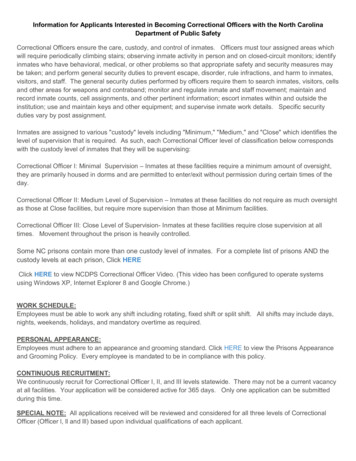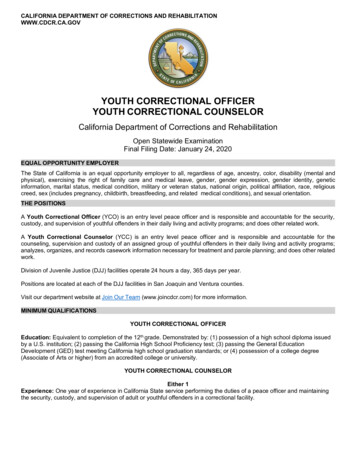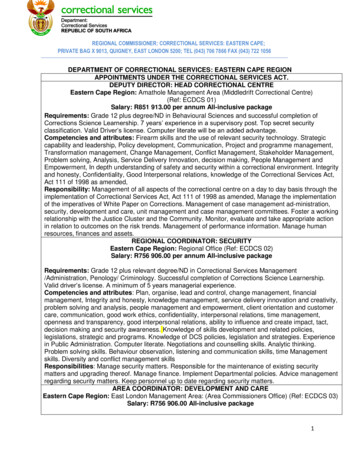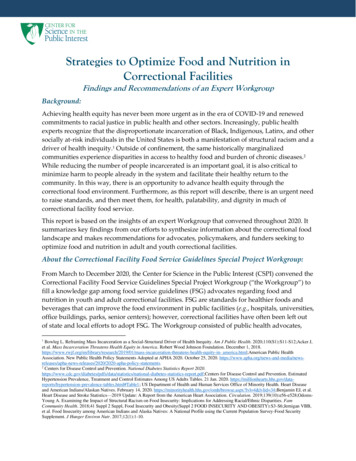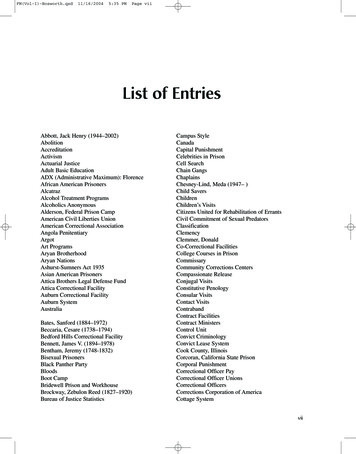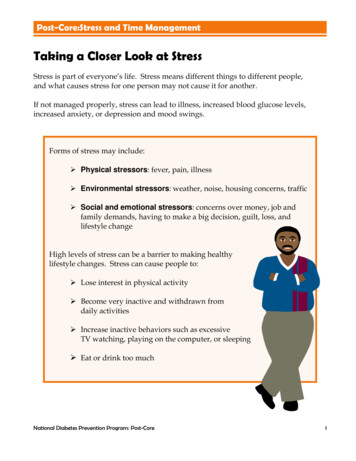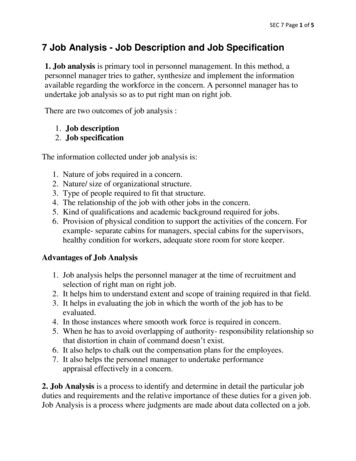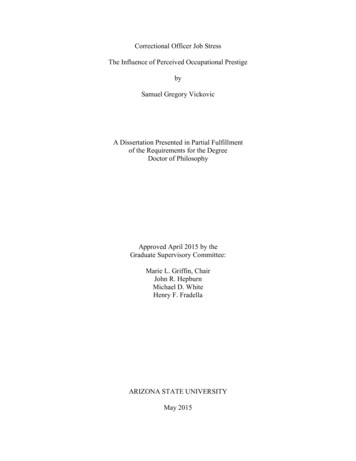
Transcription
Correctional Officer Job StressThe Influence of Perceived Occupational PrestigebySamuel Gregory VickovicA Dissertation Presented in Partial Fulfillmentof the Requirements for the DegreeDoctor of PhilosophyApproved April 2015 by theGraduate Supervisory Committee:Marie L. Griffin, ChairJohn R. HepburnMichael D. WhiteHenry F. FradellaARIZONA STATE UNIVERSITYMay 2015
ABSTRACTMore than 450,000 people work in public and private correctional institutions inthe United States, collectively supervising over 2.2 million jail and prison inmates. Thenature of correctional officers' work exposes them to numerous stressors which can haveharmful effects on their health and their job performance. Several studies have examinedthe significance of environmental factors on work outcomes among prison staff. Lessattention has been paid to external stressors such as negative images of correctionalofficers held by the community and correctional officers' perception of their ownoccupational prestige. This is an important omission considering the negative stereotypesassociated with correctional officers and the tendency for media and entertainment outletsto perpetuate these stereotypes. The aim of this dissertation is to examine how perceivedoccupational prestige among correctional officers influences job stress. Specifically, theperceived occupational prestige associated with family and friends, the general public,and the media are assessed. To do so, the study employs multivariate analyses of datafrom a survey of 641 correctional officers employed in one Western prison system toexamine the impact of perceived occupational prestige on an attitudinal and healthmeasure of job stress. First, correctional officers believe that friends and family hold themost positive opinions about their profession, while the media has the most negative.Second, perceived occupational prestige among correctional officers does not appear tobe a significant stressor, except for perceived occupational prestige associated with themedia when predicting health job stress. Finally, when possible mediating variables areassessed for officers that had tenure longer than nine years perceived occupationalprestige associated with the media has a significant effect on attitudinal and health jobi
stress. In addition, for officers who identified themselves as non-White perceivedoccupational prestige associated with family and friends is a significant predictor ofattitudinal job stress and perceived occupational prestige associated with the generalpublic is a significant predictor of health job stress. This study concludes with asummary of these findings as well as its key limitations, and offers insight into potentialpolicy implications and avenues of future research.ii
DEDICATIONThe time and energy that went into this process is dedicated to my amazingmother and the memory of my father. I would have never made it to this level in myacademic career if it were not for the love and support of my parents. Words cannotexpress how much I love and appreciate you.iii
ACKNOWLEDGMENTSFirst, I would like to thank Dr. Marie Griffin, my committee chair, and Dr. JohnHepburn for taking so much time to assist me throughout this long process. I am still inawe of how much time and effort you put into helping me and ensuring that I fullybenefited from this process. I would also like to thank Dr. Henry Fradella and Dr.Michael White for being a part of my dissertation committee and offering support andguidance.I would like to thank Weston Morrow, Lisa Dario, Matt Larson, and JohnShjarback for always being there to answer my questions, but more importantly to have agood laugh. I would like to recognize all of my good friends who kept me sane andprovided an outlet from the academic world. My brother will never know how much hehas meant to me throughout my life, and especially my time as a graduate student and Iam forever grateful to have him in my life. My amazing girlfriend Kaytie was there forme every step of the way and I cannot thank her enough for her support.iv
TABLE OF CONTENTSPageLIST OF TABLES .ixLIST OF FIGURES .xiCHAPTER1INTRODUCTION . . . 12REVIEW OF LITERATURE . 8Stress Defined . 8Correctional Officers and Stress Measurements . 10Consequences of Stress . 13Emotional Responses to Stress . 13Behavioral Responses to Stress . 14Turnover, Turnover Intent, and Absenteeism . 14Obesity and Substance Abuse. 15Psychological Responses to Stress . 16Physiological and Health Responses to Stress . 17Causes of Stress. 17Individual Characteristics of Officers . 17Organizational Characteristics . 20Job Danger. 20Role Strain . 23Social Support . 25Supervisory Support. 26v
CHAPTERPageOrganizational Support . 27External Sources of Stress . 28Work-Family Conflict. 28External Support . 30Summary . 313STATEMENT OF THE PROBLEM . 33Occupational Prestige . 33Media Portrayals of Correctional Officers . 34Occupational Prestige of Correctional Officers . 35Research Questions and Hypotheses . 394METHOD . . 44Subjects and Procedures . 44The Sample . 45Measurement . 46Independent Variables . 47Dependent Variables . 49Control Variables . 50Role Strain . 51Percieved Danger . 51Work-Family Conflict . 52Quality of Supervision . 53Organizational Support . 53vi
CHAPTERPageSocio-Demographic Varaibles . 54Data Anlaysis . 555RESULTS . . 56Bivariate Anlaysis . 56Individual-Level Variables . 56Work Environemnt Variables . 56Key Independent Variables. 57Dependent Variables . 58Summary . 58Social Distance Comparison . 59Multivariate Analysis . 60Stepwise Regression of Attitudinal Stress on the Key IndependentVariables, Work environment Variables, and Individual LevelVaraibles. . 60Stepwise Regression of Health Stress on the Key IndependentVariables, Work Environemnt Variables, and Individual LevelVariables . 63Summary . 65Stepwise Regression of Attitudinal and Health Stress on POPVariables by Level of Quality of Supervision . . . . 66Stepwise Regression of Attitudinal and Health Stress on POPVariables by Level of Organizatioanl Support. 68vii
CHAPTERPageRegression by Attitudinal and Health Job Stress on POP Variables byIndividual-Level Variables . 69Summary . 716DISCUSSION AND CONCLUSIONS . 74Social Distance of POP . 75The Influence of Individual-Level Predictors and Work Stress . 76The Relationship Between POP Domains and Work Stress . 77Assesment of Conditioning Effects Regarding the Relationship BetweenPOP and Work Stress . 80The Influence of Quality of Supervision, Organizational Support, RoleStrain, Percieved Danger, and Work-Family Conflict . 82Limitations. 85Conclusions . 87Policy Implications . 88Future Research . 93REFERENCES. . 97APPENDIXASURVEY INSTRUMENT . 135BCOVER LETTER . 138viii
LIST OF TABLESTable1.PageA Comparison of the Sample to the Population, by Prison Complex, on SelectSocio-Demographic Characteristics of the Population . 1192.Scale Information . 1203.Descriptive Statistics for All Variables Included in the Model . 1214.Correlation Matrix (Perason’s r) for Individual-Level Variables Included inMultivariate Analysis . 1225.Correlation Matrix (Perason’s r) for Key Independent and Control VariablesIncluded in Multivariate Analysis . 1236.POP and Social Distance . 1247.Regression Analysis Summary Table for Stepwise Regression of Attitudinal JobStress on POP Varaibles, Work Environment Variables, and Individual-LevelVaraibles . 1258.Regression Analysis Summary Table for Stepwise Regression of Health JobStress on POP Varaibles, Work Environment Variables, and Individual-LevelVaraibles . 1269.Regression Analysis Summary Table for Stepwise Regression of Attitudinal JobStress on POP Varaibles, Work Environment Variables, and Individual-LevelVaraibles by Level of Quality of Supervision . 12710.Regression Analysis Summary Table for Stepwise Regression of Health JobStress on POP Varaibles, Work Environment Variables, and Individual-LevelVaraibles by Level of Quality of Supervision . 128ix
Table11.PageRegression Analysis Summary Table for Stepwise Regression of Attitudinal JobStress on POP Varaibles, Work Environment Variables, and Individual-LevelVaraibles by Level of Organizational Support . 12912.Regression Analysis Summary Table for Stepwise Regression of Health JobStress on POP Varaibles, Work Environment Variables, and Individual-LevelVaraibles by Level of Organizational Support . 13013.Regression Analysis Summary Table for Regression of Attitudinal and HealthJob Stress on POP Varaibles, Work Environment Variables, and IndividualLevel Varaibles by Age . 13114.Regression Analysis Summary Table for Regression of Attitudinal and HealthJob Stress on POP Varaibles, Work Environment Variables, and IndividualLevel Varaibles by Tenure . 13215.Regression Analysis Summary Table for Regression of Attitudinal and HealthJob Stress on POP Varaibles, Work Environment Variables, and IndividualLevel Varaibles by Race/Ethnicity . 13316.Regression Analysis Summary Table for Regression of Attitudinal and HealthJob Stress on POP Varaibles, Work Environment Variables, and IndividualLevel Varaibles by Education . 13317.Regression Analysis Summary Table for Regression of Attitudinal and HealthJob Stress on POP Varaibles, Work Environment Variables, and IndividualLevel Varaibles by Sex . 134x
LIST OF FIGURESFigurePage1.Sources of Stress 119xi
CHAPTER 1INTRODUCTION“Correctional officers can always count on four things: being understaffed, unprotected,underpaid, and underappreciated.” (Glenn, 2001, p. xii)With a nearly 400 percent increase in the number of persons incarcerated in theU.S. over the past thirty years, today there are nearly 450,000 persons working ascorrectional and detention officers in U.S. jails and prisons (Bureau of Labor Statistics,2013; Sabol, West, & Cooper, 2009). State spending on corrections is approaching 50billion dollars annually (The Pew Center of the States, 2008) and three-fourths of thatamount is budgeted to cover the costs of the security staff, or correctional officerscharged with maintaining order and control in state prisons (Bureau of Labor Statistics,2013; Camp & Lambert, 2006).Correctional officers are responsible for maintaining a safe and secureenvironment for both inmates and staff. Officers are the most important resourcenecessary for accomplishing the goals and objectives of the institution (Archambeault &Archambeault, 1982; Lambert et al., 2009). Correctional officers work in a coerciveenvironment (Armstrong & Griffin, 2004; Griffin, 2001) and their work has beencharacterized as demanding, dangerous, and dirty (Armstrong & Griffin, 2004; Dowden& Tellier, 2004; Schaufeli & Peeters, 2000; Tartaro, 2002; Tracy, 2004; Tracy & Scott,2006). Brodsky (1982) suggested that any organization that is responsible for containingan unwilling population will be an organization under stress. Due to the distinctive andstressful work environment experienced by correctional officers, this unique workplacehas received considerable attention from correctional scholars (Armstrong & Griffin,1
2004; Auerbach, Quick, & Pegg, 2003; Garland, Hogan, & Lambert, 2013; Lambert etal., 2009). Stress refers to the outcome experienced when an individual is subject toenvironmental conditions that place special physical and/or psychological demands onthe individual (Sulsky & Smith, 2005). Within the correctional officer literature,researchers focus on job stress which is the response to work-related stressors such asperceived danger and inter-personal relations (Matteson & Ivancevich, 1987; Lazarus &Folkman, 1984). Research suggests that correctional officers have high levels of stress(Auerbach, et al., 2003; Schaufeli & Peeters, 2000; Whitehead & Lindquist, 1986), andthey are more stressed relative to other occupations (including police officers)(Bourbonnais, Malenfant, Vezina, Jauvin, & Brisson, 2005; Harenstam, Palm, &Theorell, 1988; Johnson et al., 2005; Lasky, Gordon, Strebalus, 1986; Lindquist &Whitehead, 1986; Patterson, 1992).Stress has received a great deal of attention due to the negative outcomesassociated with stress (American Psychological Association, 2009; Sulsky & Smith,2005). Research on correctional officer job stress suggests that increased job stressresults in decreased levels of job satisfaction and organizational commitment, andincreased job burnout (Balu, Light & Chamlin, 1986; Garner, knight, & Simpson, 2007;Griffin, Hogan, Lambert, Tucker-Gail, & Baker, 2010; Hogan, Lambert, & Griffin, 2013;Hogan, Lambert, Jenkins & Hall, 2009; Keinan & Malach-Pines, 2007; Lambert, 2004;Lambert & Hogan, 2004; Robinson, Porporino, & Simourd, 1997; Van Voorhis, Cullen,Link, & Wolfe, 1991; Walters, 1992; Whitehead & Lindquist, 1986). Correctionalofficers who are satisfied, committed to the organization, and are not burned outexperience increased job performance, prosocial organizational behavior, increased2
human service orientation, and decreased turnover intent (Culliver, Sigler, & McNeely,1991; Garland, 2002; Hepburn & Knepper, 1993; Kerce, Magnusson, & Rudolph, 1994;Lambert, Hogan, & Griffin, 2008; Lambert, Hogan, Paoline, & Baker, 2005; Maslach &Jackson, 1981; Neveu, 2007; Robinson, Porporino, & Simourd, 1992; Schaufeli &Peeters, 2000). In addition to possible negative work-related outcomes, stress has beenassociated with negative medical, psychological, and behavioral conditions such asdepression, hypertension, and turnover (Bierie, 2012; Cheek, 1984; Cheek & Miller,1983; Denhof & Spinaris, 2013; Ferraro, Faghri, Henning, & Chermiack, 2013; Ghaddar,Mateo, & Sanchez, 2008; Harenstam et al., 1988; Morse, Dussetchleger, Warren, &Cherniack, 2011; New Jersey Police Task Force Report, 2009; Samak, 2003; Spinaris,Denhof, and Kellway, 2012; Stack & Tsoudis, 1997; Webster, Porritt, & Brennan, 1983;Weir, Stewart, & Morris, 2012).Considering the harmful effects of job stress, it is important to understand thecauses of job stress. Among correctional officers and correctional staff, role conflict, roleambiguity, perceptions of danger, work-family conflict, organizational support, andquality of supervision are among the strongest predictors of job stress (Armstrong &Griffin, 2004; Cheek & Miller, 1983; Cullen, Link, Wolfe, & Frank, 1985; Dowden &Tellier, 2004; Griffin, 2006; Grossi, Keil, & Vito, 1996; Hartley, Davila, Marquart, &Mullings, 2013; Jurik & Halemba, 1984; Keinen & Malach-Pines, 2007; Lambert &Hogan, 2009, 2010; Lambert, Hogan, & Grifin, 2007; Lindquist & Whitehead, 1986;Schaufeli & Peeters, 2000; Shamir & Drory, 1982; Triplett, Mullings, & Scarborough,1996; Van Voorhis et al., 1991). In addition, several other predictors of stress amongcorrectional officers have been highlighted, including the demands of daily contact with3
inmates, low pay and low promotional opportunities, lack of job autonomy, the conflictsbetween security and treatment orientations, negative perceptions of inmates, officer’sperceived level of professionalism, organizational innovation, adequacy of training,questions of distributive and procedural justice, and the physical environment (extremeheat or cold, intrusive noise, little privacy, dilapidation of structures) (Bierie, 2012;Castle & Martin, 2006; Cheek & Miller, 1983; Cullen et al., 1985; Dowden & Tellier,2004; Finn, 1998; Lambert & Hogan, 2010a; Lambert, Hogan, & Allen, 2006; Lambert &Paoline, 2008; Misis, Cheeseman, Hogan, & Lambert, 2013; Paoline & Lambert, 2011;Robinson et al., 1997; Schaufeli & Peeters, 2000; Slate & Vogel, 1997; Stohr, Self, &Lovrich, 1992; Tewksbury & Higgins, 2006).The absence of social support also may become a stressor. Supervisory support,co-worker support, and organizational support have been highlighted in the correctionalofficer stress literature (Cullen et al., 1985; Dowden & Tellier, 2004; Maslach, Schaufeli,& Leiter, 2001; Misis et al., 2013; Schaufeli & Peeters, 2000; Van Voorhis, 1991), butthere has been much less attention concerning the effect of support from outside the workenvironment on officer stress levels. This external support typically is explored in termsof support from the family and the community. In addition, research has examinednegative public image as a measure of a lack of support that originates when a professionexperiences low levels of occupational prestige within the general public and the media.Support from the community and family has been shown to decrease job stress amongcorrectional officers (Cullen et al., 1985; Shamir & Drory, 1982). Studies of correctionalofficers employed outside of the United States suggest that a perceived negative publicimage is a significant predictor of job stress, as well as low job satisfaction and job4
burnout (Drory & Shamir, 1988; Keinan & Malach-Pines, 2007; Moon & Maxwell, 2004;Shamir & Drory, 1982). Occupational prestige refers to the status, power, quality ofwork, education, and income associated with one’s profession (Coxon & Jones, 1978;Treiman, 1977). The public often stereotypes correctional officers as lazy, sexuallydeviant, brutal, aggressive, and uncaring (Brodsky, 1982; Cheek & Miller, 1982; Cheek& Miller, 1983; Conover, 2001; Freeman, 1998; Johnson, 2002; Kauffman, 1988; Tracy,2004). Correctional officers are conscious of these stigmas and reference the fact thatthey are often seen as “the scum of law enforcement” and “glorified babysitters” (Tracy,2004; Tracy & Scott, 2006). In addition, they work in an environment that is associatedwith dirty, unfavorable conditions with their primary role of supervising a stigmatizedinmate population (Tracy, 2004; Tracy & Scott, 2006). These negative qualitiesassociated with their work are often projected upon the workers themselves (Goffman,1963). As a result, correctional officers may perceive low occupational prestige whichsubsequently may act as a stressor.The problem of low levels of perceived occupational prestige is exacerbated bythe fact that the operations and daily life of those working and housed in correctionalinstitutions are hidden from society (Brodsky, 1982; Foucalt, 1977; Garland, 1990;Sussman, 2002; Brower, 2013). This leads to a situation of increased social distancewherein correctional officers are unable to portray a different professional image throughinteraction and visibility among the public. As a result, most information that the publicreceives concerning correctional officers is through the media which too oftenperpetuates the negative stereotypes of correctional officers (Bennett, 2006; Brower,2013; Cecil & Leitner, 2009; Finn, 1998; Freeman, 1998; Johnson, 2002; Johnson &5
Price, 1981; Kantrowitz, 1996; Levan, Polzeret, & Downing, 2011; Levenson, 2001;May, 1976; Meiners, 2007; Morgan, 2009; Smith, 1994; Van Fleet, 1992; Zaner, 1989).Research suggests that the news media and cinematic representations overwhelminglyportray correctional officers negatively (Bennett, 2006; Bennet & Satre, 2000; Freeman,1998; Kantrowitz, 1996; Vickovic, Griffin, & Fradella, 2013; Zaner, 1989). Althoughmedia depictions are negative, those who are close to correctional officers (e.g. familyand friends) have a better understanding of the role of a correctional officer and arealization of the inaccurate negative stereotypes perpetuated by the media. Researchsuggests that opinions are influenced by familiarity with the subject (Anagnostopoulos &Hantzi, 2011; Corrigan, Edwards, Green, Diwan, & Penn, 2001; Holmes, Corrigan,Williams, Canar, & Kubiak, 1999), and that there is significant variation in the influenceof individuals and groups on factors such as opinions and behaviors depending on socialdistance and contact with the individual (Glynn & Park, 1997; Krassa, 1988; Oshagen,1996; Perkins, 2002; Shibutani, 1955). As such, social distance from correctionalofficers may influence opinions regarding their profession.Although there has been extensive research on the causes of work stress amongcorrectional officers, much has focused on how the work environment influences stress;consideration of how the perceived prestige of the job (or lack thereof) may influencestress remains relatively unexplored. The closed nature of prisons and the negativedepictions of correctional officers in news and entertainment media may serve toaggravate low perceived prestige among correctional officers. The purpose of this studyis to assess the relationship between perceived occupational prestige and correctionalofficer stress, as well as how perceived beliefs of different audiences (family and friends,6
neighbors and townspeople, general public, and media) influence correctional officerstress. The perceived occupational prestige associated with these different audiences isexamined in order to assess the relationship between perceived occupational prestige ofcertain groups (e.g. family and friends or general public) and stress. Furthermore, thisstudy assesses what factors may moderate the relationship between low perceivedoccupational prestige and job stress.7
CHAPTER 2REVIEW OF LITERATURESTRESS DEFINEDStress is a term that is commonly used to refer to a multitude of experiences in avariety of contexts, ranging from technical biomedical discussions, to conversationsregarding daily life events. As a result, the term stress varies across different disciplinesand is conceptualized and defined in a variety of ways (Sulsky & Smith, 2005). Mattesonand Ivancevich (1987) highlighted the fact that the word stress has so many meanings todifferent individuals that it has been described as the most imprecise term in theScientific Dictionary. The formal use of the term stress to reference negative responsesto life events dates back to the early 1900s (Abbott, 1990). Early work concerning thestudy of stress was conducted by endocrinologists and was not used regularly inmainstream literature until the 1950s when it was made popular by Hans Selye’s (1956)work (see also Baum, Grunberg, & Singer, 1982; Cannon, 1936).Stress has been broken down into stimulus definitions which focus on an event orsituation (stressor) in the environment that causes a disruptive experience (Cooper &Marshall, 1976; Sulsky & Smith, 2005). Others have focused on response definitions thathighlight the reaction the individual has to the stressor. Medical and biologicalperspectives on stress use this definition due to a primary interest in the reaction of theindividual (Selye, 1956; Sulsky & Smith, 2005). The most common definition describesstress as a process that starts with an individual perceiving an event or environment asthreatening or traumatic (Baum et al., 1982; Lazarus, 1966). Once an individualperceives a stressor, the elicited stress response comes in many forms including8
physiological, psychological, cognitive, behavioral, and emotional (Lazarus, 1966;Matteson & Ivancevich, 1987). A more general definition describes stress as “anycircumstance (stressor) that places special physical and/or psychological demands on anorganism leading to physiological, psychological, and behavioral outcomes” (Sulsky &Smith, 2005, p. 6). Although there is some agreement on a general definition of stress,scholars emphasize the fact that there needs to be considerable effort to reach a standarddefinition of stress for the purpose of ongoing research on stress and its effects (Abbott,1990; Baum et al., 1982; Sulsky and Smith, 2005).Ivancevich and Matteson (1980) identified a measurement of stress thatincorporated two categories: a medical research approach and a behavioral scienceapproach. The medical research approach requires particip
Correctional officers are responsible for maintaining a safe and secure environment for both inmates and staff. Officers are the most important resource necessary for accomplishing the goals and objectives of the institution (Archambeault & Archambeault, 1982; Lambert et al., 2009). Correctional officers work in a coercive


